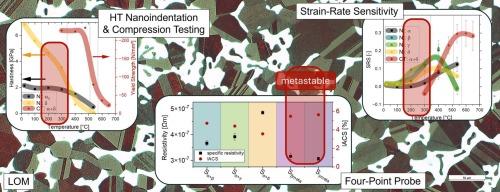Metastability Matters: Exploring hardness and conductivity in bell bronze alloys
IF 7.9
2区 材料科学
Q1 MATERIALS SCIENCE, MULTIDISCIPLINARY
引用次数: 0
Abstract
The Cu-Sn alloy system exhibits diverse stable and metastable phases with complex phase transformations, making it attractive for applications requiring tailored mechanical and electrical performance. This study investigates the mechanical response of individual phases during ongoing phase transformations in a Cu-20 m.% Sn alloy. Heat treatments produced large-grained microstructures containing distinct phase combinations in equilibrium and non-equilibrium states. The evolving microstructure was characterized using light optical and scanning electron microscopy. Phase-specific hardness, Young’s modulus, and strain rate sensitivity were determined through room-temperature and high-temperature nanoindentation combined with electron back-scattered diffraction phase mapping, alongside compression testing. This method enables direct quantification of phase properties under phase transformation, separating the contributions of stable and metastable phases. Results reveal how transformation kinetics and solute interactions govern the phase-specific deformation bulk performance, offering new insights into structure–property relationships in Cu-Sn alloys. The methodology provides a framework for phase-specific property characterization in transforming systems, supporting the design of materials with transformation-informed properties optimization.

亚稳态问题:探索钟青铜合金的硬度和电导率
Cu-Sn合金体系具有多种稳定相和亚稳相,具有复杂的相变,使其对需要定制机械和电气性能的应用具有吸引力。本文研究了cu - 20m .% Sn合金相变过程中各相的力学响应。热处理产生了大晶粒的微观组织,在平衡和非平衡状态下含有不同的相组合。利用光学显微镜和扫描电镜对其微观结构进行了表征。通过室温和高温纳米压痕结合电子背散射衍射相图以及压缩测试来确定相特定硬度、杨氏模量和应变率灵敏度。这种方法可以直接量化相变下的相性质,分离稳定相和亚稳相的贡献。结果揭示了相变动力学和溶质相互作用如何控制相形变体积性能,为Cu-Sn合金的结构-性能关系提供了新的见解。该方法为转换系统中的相位特定特性表征提供了一个框架,支持具有转换信息特性优化的材料设计。
本文章由计算机程序翻译,如有差异,请以英文原文为准。
求助全文
约1分钟内获得全文
求助全文
来源期刊

Materials & Design
Engineering-Mechanical Engineering
CiteScore
14.30
自引率
7.10%
发文量
1028
审稿时长
85 days
期刊介绍:
Materials and Design is a multi-disciplinary journal that publishes original research reports, review articles, and express communications. The journal focuses on studying the structure and properties of inorganic and organic materials, advancements in synthesis, processing, characterization, and testing, the design of materials and engineering systems, and their applications in technology. It aims to bring together various aspects of materials science, engineering, physics, and chemistry.
The journal explores themes ranging from materials to design and aims to reveal the connections between natural and artificial materials, as well as experiment and modeling. Manuscripts submitted to Materials and Design should contain elements of discovery and surprise, as they often contribute new insights into the architecture and function of matter.
 求助内容:
求助内容: 应助结果提醒方式:
应助结果提醒方式:


